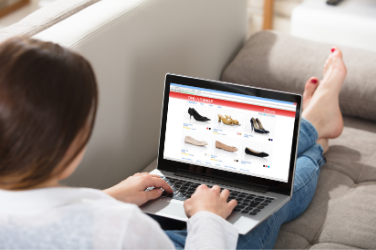Selling your product through online marketplaces
Apr 8, 2020,
by Austin Gleeson, GS1 Ireland - Category: Retail Marketplaces
Right now, you might be considering how to sell more of your products online.
Selling online allows even the smallest business to reach a massive market across the world.

Despite the large number of e-commerce tools and courses available selling online and in marketplaces is competitive and can be very complicated. Here are some things to consider before getting started when selling online.
How Can I Sell My Products Online?
There are two main ways businesses sell their products online:
1. On their own website
2. Through a third-party site

Selling Through Your Own Website
Selling through your own website can be a great way to convert your website visitors, social followers and bricks-and-mortar patrons into e-commerce sales. You will also learn great digital marketing and user experience (UX) skills.
The flipside is the time and money required to build a secure website, select a selling platform (e.g. Woocommerce, Shopify, Magento, etc.) and to grow traffic to your website.
One of the biggest challenges small businesses face when selling online is getting lost in the shuffle, particularly when being outspent by larger competitors when it comes to marketing and advertising.
Selling with Third Party Sites
Online marketplaces are third-party websites which allow you to sell your products without having to create a separate website and online store – some of the most popular ones include Amazon, eBay and Etsy. These platforms usually do not own any inventory, their business involves making producers’ inventory available for consumers and to facilitate transactions between buyers and sellers.
There are lots of different types of marketplaces, they can be global (eBay) or local (The Doorstep Market), they can have a wide range of products (Amazon) or cater to a specific niche (Cuando).
Why sell your product on Marketplaces?
Building a website, creating an e-commerce store and driving traffic there can be too expensive for a lot of small businesses. If you are selling online, you want to generate as much profit as you can without creating more work. This is one of the main reasons why smaller businesses tend to begin their ecommerce journey with online marketplaces.
Marketplace platforms also have the benefits of strong brand awareness, customer trust and high levels of site traffic. While these marketplaces will charge fees, they will generally be cheaper than building your own e-commerce infrastructure from scratch. Marketplaces allow small producers to focus on what they do best, making and improving their products instead of worrying about creating online stores and finding customers.
In an ever-changing digital retail environment, one of the major trends is that of shoppers researching and purchasing in the same channels. In 2017 49% of US customers began their product searches on Amazon, compared to just 35% on search engines. As voice search, and in-home virtual assistants like Alexa continue to grow in popularity, this is a trend that is set to grow in all markets.
Creating a marketplace account for your business isn’t just a way to generate more sales. Online shoppers don’t get to touch and feel your products before their purchase them. The majority of customers read online reviews before they make a purchasing decision, and marketplace are one of the most trusted sources for online product reviews.
There are a lot of great communities and supports out there for small businesses, and when you join an e-commerce marketplace you become part of a global community of other independent sellers, producers and retailers.
Selecting Your Marketplaces
Before signing up for a Marketplace, it’s important to consider which one is right for your business and your product. The biggest marketplaces might seem like the most attractive, but how will your product cut through the clutter, and is your business able to cope with a large volume of international orders if your product gets popular?
With so many new, niche and regional marketplaces opening, there are options for so many producers to sell their products online.

Who am I selling to and what do they want?
The best place to start is to with your potential customer and the product they are looking for. This may seem obvious, but the customer you are selling to in a physical store could be quite different to the one who is looking for your product online.
A simple exercise is to search online for the smallest niche for your product based on your product’s attributes, qualities and the pain points it solves for customers. This approach will allow you to begin your ecommerce journey in a marketplace with less competition and a more targeted audience.
Find how to identify your micro niche here.
Comparing Marketplace Scale & Support
While one of the major benefits to selling your product on marketplaces is the ready-made customer base, it helps to check the marketplace’s site traffic statistics. While the quality of visitors is arguably more important, understanding the quantity of website traffic is still worthwhile, particularly if you're looking at the less-established, niche marketplaces. Some free tools that will help include: SEMrush, UberSuggest & Alexa.
Shipping & Payment Integrations
Some marketplaces will provide an end-to-end service, but you may need how you process payments and ship your products. Some platforms offer an end-to-end payment service, but while these may seem like the easiest way to get paid on a marketplace, make sure you take the time to review the terms and conditions. Perhaps now is the time to set up a PayPal account, or look into new mobile payment apps.
There are many ways for you to ship products to buyers, with options from manual labeling through to paid integrations with shipping software providers (e.g. ShipStation, Shippo, etc.). Your shipping options may be limited by the marketplace you signup with, and you’ll need to consider your options if you are selling internationally.
When working with a marketplace, you will have less flexibility, control and will be subject to their rules and regulations. Make sure to research the terms and conditions that apply when it comes to listing your product, and whether or not there are specific rules you are required to comply with when it comes to returns. An example of this is eBay's Money Back Guarantee policy.
Creating an Account
One of the main benefits about selling your products on a marketplace is how simple it is to get set up. On Amazon or eBay you could be selling in a matter of hours. For most marketplace platforms, getting started is as easy as clicking a “Sign Up” button.
Several platforms make it very easy to sign-up to their platform, allowing you to register with an existing account such as Google, Facebook or Twitter.

From there, you’ll need to answer some questions about your store, what you are selling and some business information. As a GS1 Ireland member you will have GTINs if they are a mandatory requirement for a specific marketplace.
There are different programmes, plans and fees for each marketplace site ranging from monthly subscriptions, sale price commission or minimum referral fees. Many marketplaces also offer advertising and marketing services, usually on a pay-per-click model.
It can be easy to build a great stack of marketing services to help increase your products visibility and sales with these third parties. A combination of advertising services, marketplace fees and shipping costs can eat into your margin. There are several online trackers that allow sellers to keep track of their margins, Salecalc.com is a quick way to track and calculate fees and revenue from a number of major Marketplaces.
Selling your products through online marketplace is a great first step into the world of ecommerce. The largest marketplace operators are increasingly focused on ensuring the best shopper experience, providing high quality data catalogues and reducing counterfeit products. These operators ensure this high level of quality by requiring sellers to include unique product identifiers.
When you are setting up your account on Amazon and are requested to enter a GTIN, UPC or EAN, you know that as a GS1 Ireland member, this is your barcode number and that you can continue to list, and sell your products with confidence.
Haven't got your GS1 Ireland barcodes yet? Sign Up here
Tags: Marketplace, ecommerce, amazon, ebay, GTIN, google, shopping,